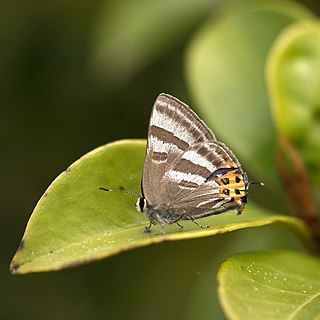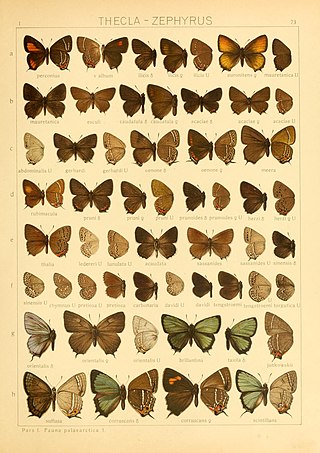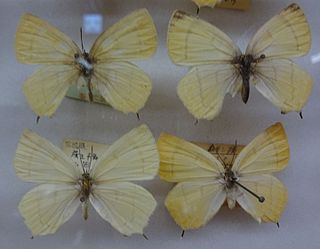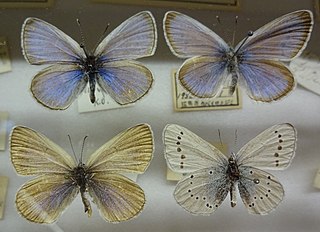
Lycaena phlaeas, the small copper, American copper, or common copper, is a butterfly of the Lycaenids or gossamer-winged butterfly family. According to Guppy and Shepard (2001), its specific name phlaeas is said to be derived either from the Greek φλέγω (phlégo), "to burn up", or from the Latin floreo, "to flourish".

Cyaniris semiargus, the Mazarine blue, is a Palearctic butterfly in the family Lycaenidae.

The Theclini are a tribe of butterflies in the family Lycaenidae. As not all Theclinae have been assigned to tribes, the genus list is preliminary.

The scarce large blue is a species of butterfly in the family Lycaenidae. It is found in Austria, Slovenia, Croatia, the Czech Republic, France, Georgia, Germany, Hungary, Italy, Japan, Kazakhstan, Mongolia, the Netherlands, Poland, Romania, Russia, northern Serbia, Spain, Switzerland, and Ukraine and East across the Palearctic to Japan. The species was first described by Johann Andreas Benignus Bergsträsser in 1779.

Plebejus is a genus of butterflies in the family Lycaenidae. Its species are found in the Palearctic and Nearctic realms.

Wagimo is a small East Asian genus of butterflies in the family Lycaenidae.

Rapala arata, the Japanese flash, is a butterfly of the family Lycaenidae. It is found from Russia, north-eastern China, Korea and Japan. The habitat consists of brook banks, meadows and the edges of montane mixed forests.

Favonius taxila is a butterfly in the family Lycaenidae. It is found in the Russian Far East, north-eastern China, Korea and Japan.

Favonius saphirinus is a butterfly in the family Lycaenidae. It is found in the Russian Far East, north-eastern China, Korea and Japan.

Gonepteryx maxima is a butterfly of the family Pieridae. It was described by Arthur Gardiner Butler in 1885. It is found from north-eastern China to Korea, Japan, the Russian Far East and Japan. The habitat consists of steppe and forest-steppe areas.

Thecla betulina is a butterfly of the family Lycaenidae. It was described by Otto Staudinger in 1887. It is found in the Russian Far East, north-eastern China and Korea. The species is found in the forest belt where it inhabits forest edges and river valleys.

Satyrium prunoides is a butterfly of the family Lycaenidae. It was described by Otto Staudinger in 1887. It is found in the Russian Far East, Mongolia, north-eastern China and Korea.

Shirozua jonasi, the orange hairstreak, is a butterfly of the subfamily Lycaeninae. It was described by Edward Wesley Janson in 1877. It is found in the Russian Far East, north-eastern China, Korea and Japan. It is widely distributed in the forest belt.
Elophila orientalis is a moth in the family Crambidae. It was described by Ivan Nikolayevich Filipjev in 1933. It is found in China, Japan and the Russian Far East (Ussuri).

Elophila turbata is a moth in the family Crambidae found in Africa and Asia. It was first described by the English entomologist Arthur Gardiner Butler in 1881 from a specimen found in Yokohama, Japan.
Potamomusa midas is a moth in the family Crambidae. It was described by Arthur Gardiner Butler in 1881. It is found in Japan, China, the Russian Far East and Korea.

Oreta turpis is a moth in the family Drepanidae. It was described by Arthur Gardiner Butler in 1877. It is found in Japan, the Russian Far East, Korea and China (Shandong).

Glaucopsyche lycormas is a butterfly of the family Lycaenidae. It is found in the East Palearctic in Siberia, Mongolia, China, Korea and Japan.

Japonica lutea is a small butterfly found in the East Palearctic that belongs to the lycaenids or blues family.

















